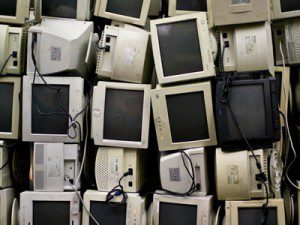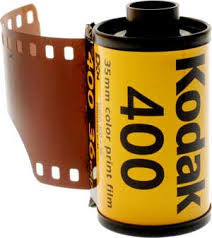 A couple of Saturdays ago, the district Scouts assembled in a local box store parking lot. They had a large dumpster – open at one end – into which they were piling used electronic equipment that folks around town wanted to discard. By the time a photographer friend and I arrived there about midday for a peek at what was going on, the dumpster was nearly full. He and I began nosing through the discarded electronics to see what the Scouts had collected.
A couple of Saturdays ago, the district Scouts assembled in a local box store parking lot. They had a large dumpster – open at one end – into which they were piling used electronic equipment that folks around town wanted to discard. By the time a photographer friend and I arrived there about midday for a peek at what was going on, the dumpster was nearly full. He and I began nosing through the discarded electronics to see what the Scouts had collected.
“Old, well-used, communications artefacts,” I said and then asked my buddy, “I wonder whether you and I qualify?”
As it turned out, my friend had a pretty sophisticated camera hanging around his neck – huge lens, lots of digital memory and all the doodads that go with a modern camera that most people couldn’t operate. On the other hand, as I poked around the dumpster, I had to admit that I knew exactly what each piece of discarded electronics was, and that at one time I had operated every one of the used items in the pile. There were stereos (turntables and amplifiers), pagers, bulky TV sets, VHS and even Beta tape playback units, computer towers and an array of telephone junk that probably only Alexander Graham Bell would recognize. I had actually stopped by to contribute; I had a broken printer/scanner that I’d learned was more expensive to repair than to replace.
 It was actually a pretty tough week for electronics. Earlier, Future Shop had announced it was closing 131 stores across Canada, eliminating about 500 full-time and 1,000 part-time positions. One of the employees was even quoted in the newspapers saying “we thought it was an April Fools’ joke,” but not so. I thought what a waste of merchandise and retail space the closing was. But even more, I thought what a waste of knowledge. In all the times I’ve ever been in Future Shop, and other places like it, I’ve always marvelled at the electronics savvy of the staff. To be a specialist at such things, I’m sure takes time, effort and awareness of the technology being marketed and sold. Suddenly, all that know-how was on the street. Where was it going to go?
It was actually a pretty tough week for electronics. Earlier, Future Shop had announced it was closing 131 stores across Canada, eliminating about 500 full-time and 1,000 part-time positions. One of the employees was even quoted in the newspapers saying “we thought it was an April Fools’ joke,” but not so. I thought what a waste of merchandise and retail space the closing was. But even more, I thought what a waste of knowledge. In all the times I’ve ever been in Future Shop, and other places like it, I’ve always marvelled at the electronics savvy of the staff. To be a specialist at such things, I’m sure takes time, effort and awareness of the technology being marketed and sold. Suddenly, all that know-how was on the street. Where was it going to go?
 The higher the high-tech, it seems to me, the higher the risk of being eclipsed, the more rapid the obsolescence, and even the more open to criticism. Maybe that’s what overtook the other notable high-tech newsmaker last week: the “Hello Barbie” doll. If you didn’t notice it, I’m sure your kids or grandkids did. This was the latest version of the Mattel doll, created back in 1959 by inventor Ruth Handler.
The higher the high-tech, it seems to me, the higher the risk of being eclipsed, the more rapid the obsolescence, and even the more open to criticism. Maybe that’s what overtook the other notable high-tech newsmaker last week: the “Hello Barbie” doll. If you didn’t notice it, I’m sure your kids or grandkids did. This was the latest version of the Mattel doll, created back in 1959 by inventor Ruth Handler.
Only this latest edition didn’t just have its shapely physique and high-fashion clothing. The 2015 edition sported web connection and speech-recognition software. In other words, a child could tap into the Barbie (Mattel) website and have a conversation with her doll; so, its critics suggested, could Mattel connect and converse with the kids. Child safety watchdogs claimed such a connection “violated children’s privacy.”
“My whole philosophy of Barbie,” Ruth Handler once said, “was that through the doll, the little girl could be anything she wanted to be.”
Even, it turns out, Big Brother, if you get my drift.
Coincidentally, this past week, I happened to be rifling through some junk in my office desk drawer and I came across an old thermometer. Yes, I mean old enough to have just one set of numbers on it – all Fahrenheit. My timing was coincidental. It was on April 1, 1975, 40 years ago this week, that we were forced to toss that old thermometer for the ones with Celsius readings on them. And I get it. I understand that it’s a metric world (everywhere except the United States and they’ll never join the rest of the world on that one).
Still, it warmed my heart to realize that I still knew I can skate on a pond where the temperature’s below 32 degrees, that my normal body temperature is 98.6 degrees and that water boils at 212 degrees Fahrenheit. Nevertheless, I’ve adapted more or less to metric on the highway traffic signs, in the grocery stores and on my car’s odometer.
 I guess old technology will stay with us only as long as those who remember how it works can use it and/or repair it.
I guess old technology will stay with us only as long as those who remember how it works can use it and/or repair it.
By the way, despite the good-natured jab at my photographer friend about our being communications dinosaurs, I never let on that I still have a Nikon camera that uses film. On occasion, whenever I really want to “take a photograph,” I bring out the Nikon, take my time organizing the shot, and click the shutter. Problem now is, there aren’t many places around anymore that will develop my film, much less print the photograph.
So much for my Kodak moments.